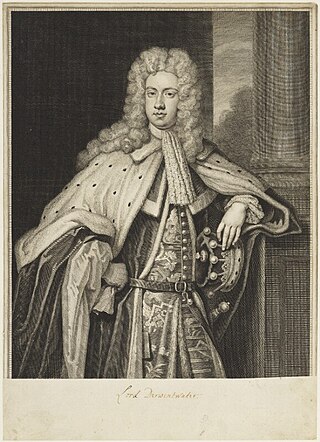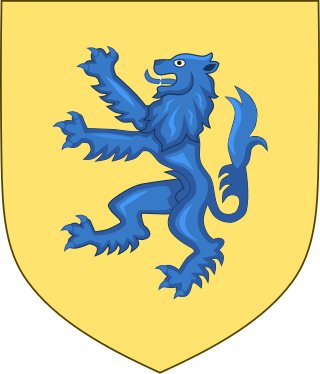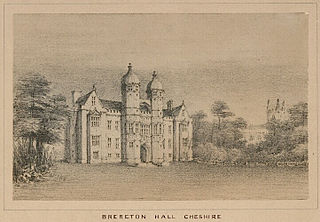
Earl of Chichester is a title that has been created three times, twice in the Peerage of England and once in the Peerage of the United Kingdom. The current title was created in the Peerage of the United Kingdom in 1801 for Thomas Pelham, 2nd Baron Pelham of Stanmer.

Earl of Roden is a title in the Peerage of Ireland. It was created in 1771 for Robert Jocelyn, 2nd Viscount Jocelyn. This branch of the Jocelyn family descends from the 1st Viscount, prominent Irish lawyer and politician Robert Jocelyn, the son of Thomas Jocelyn, third son of Sir Robert Jocelyn, 1st Baronet, of Hyde Hall. He notably served as the Lord Chancellor of Ireland from 1739 to 1756. In 1743, he was raised to the Peerage of Ireland as Baron Newport, of Newport, and in 1755 he was further honoured, when he was made Viscount Jocelyn, also in the Peerage of Ireland. He was succeeded by his son, the second Viscount. He represented Old Leighlin in the Irish House of Commons and served as Auditor-General of Ireland. In 1770 he also succeeded his first cousin once removed as fifth Baronet of Hyde Hall. In 1771 he was created Earl of Roden, of High Roding in the County of Tipperary, in the Peerage of Ireland. Lord Roden married Lady Anne Hamilton, daughter of James Hamilton, 1st Earl of Clanbrassil and sister of James Hamilton, 2nd Earl of Clanbrassil, a title which became extinct in 1798.
Earl of Bradford is a title that has been created twice, once in the Peerage of England and once in the Peerage of the United Kingdom. It was first created in 1694 for Francis Newport, 2nd Baron Newport. However, all the Newport titles became extinct on the death of the fourth Earl in 1762. The earldom was revived in 1815 for Orlando Bridgeman, 2nd Baron Bradford. The Bridgeman family had previously succeeded to the Newport estates. The title of the peerage refers to the ancient hundred of Bradford in Shropshire, and not, as might be assumed, to the city of Bradford, Yorkshire, or the town of Bradford-on-Avon in Wiltshire.
Baron Ravensworth, of Ravensworth Castle in the County Palatine of Durham and of Eslington Park in the County of Northumberland, is a title in the Peerage of the United Kingdom.

Baron Harlech, of Harlech in the County of Merioneth, is a title in the Peerage of the United Kingdom. It was created in 1876 for the Conservative politician John Ormsby-Gore, with remainder to his younger brother William. He had previously represented Carnarvon and North Shropshire in the House of Commons. Ormsby-Gore was the eldest son of William Ormsby-Gore, Member of Parliament for County Leitrim, Carnarvon and North Shropshire, and the great-great-great-grandson of William Gore, third and youngest son of Sir Arthur Gore, 1st Baronet, of Newtown, second son of Sir Paul Gore, 1st Baronet, of Magharabag, whose eldest son Paul was the grandfather of Arthur Gore, 1st Earl of Arran.

Earl of Derwentwater was a title in the Peerage of England. It was created in 1688 for Sir Francis Radclyffe, 3rd Baronet. He was made Baron Tyndale, of Tyndale in the County of Northumberland, and Viscount Radclyffe and Langley at the same time, also in the Peerage of England. He was succeeded by his son, the second Earl, who married Lady Mary Tudor, daughter of Charles II by his mistress Moll Davis.

The Percy family is an English noble family. They were among the most powerful noble families in Northern England for much of the Middle Ages. The noble family is known for its long rivalry with the House of Neville, another family powerful in northern England during the 15th century. The Percy-Neville feud led to the Wars of the Roses, at the time known as the Civil Wars, in England.

Earl of Panmure was a title in the Peerage of Scotland. It was created in 1646 for Sir Patrick Maule, a former Gentleman of the Bedchamber to James VI and loyal follower of Charles I. He was made Lord Brechin and Navar at the same time, also in the Peerage of Scotland. Both titles were forfeit by the attainder of the 4th Earl in 1716 on account of his participation in the Jacobite rising of 1715. The heirs apparent to the Earldom were styled Lord Maule. The seat of the Earldom was Panmure House, built in the 17th century near Monikie, Angus.
William Widdrington, 1st Baron Widdrington was an English landowner and politician who sat in the House of Commons from 1640 to 1642 and was created a peer in 1643. He fought in the Royalist army in the English Civil War and was killed in battle in 1651.

Blankney is a village and civil parish in the North Kesteven district of Lincolnshire, England. The population of the civil parish at the 2011 census was 251. The village is situated approximately 9 miles (14 km) south from the city and county town of Lincoln and 9 miles north from Sleaford.

Baron Brereton, of Leighlin in the County of Carlow, was a title in the Peerage of Ireland. It was created on 11 May 1624 for Sir William Brereton, of Brereton, Cheshire.

Viscount Maynard, of Easton Lodge in the County of Essex, was a title in the Peerage of Great Britain. It was created in 1766 for Charles Maynard, 6th Baron Maynard, Lord-Lieutenant of Suffolk. He was made Baron Maynard, of Much Easton in the County of Essex, at the same time, also in the Peerage of Great Britain. Both titles were created with special remainder, failing male issue of his own, to his kinsman Sir William Maynard, 4th Baronet. The 1st Viscount was unmarried and on his death in 1775 the baronetcy of Easton Parva, the Irish barony of Maynard created in 1620 and the English barony of Maynard created in 1628 became extinct. He was succeeded in the barony of 1766 and the viscountcy according to the special remainder by his kinsman Sir Charles Maynard, 5th Baronet, who became the 2nd Viscount. The latter was succeeded by his nephew, the 3rd Viscount, who served as Lord-Lieutenant of Essex. He had no surviving male issue and on his death in 1865 the baronetcy, barony and viscountcy became extinct. His granddaughter, Daisy Maynard, daughter of Colonel Charles Henry Maynard and future wife of Francis Greville, 5th Earl of Warwick, succeeded to most of the Maynard estates.

Baron Grey of Werke (or Warke), of Chillingham in the County of Northumberland, was a title in the Peerage of England. It was created on 11 February 1624 for Sir William Grey, 1st Baronet. He had already been created a baronet, of Chillingham in the County of Northumberland, in the Baronetage of England on 15 June 1619. The third Baron was created Viscount Glendale and Earl of Tankerville in the Peerage of England in 1695. He left two daughters but no sons and on his death in 1701 the viscountcy and earldom became extinct. He was succeeded in the barony by his younger brother, the fourth Baron. The latter had previously represented Berwick in Parliament. The barony became extinct on his death in 1706.

William Bagot, 1st Baron Bagot, known as Sir William Bagot, 6th Baronet, from 1768 to 1780, was a British politician who sat in the House of Commons from 1754 to 1780. He was then raised to the peerage as Baron Bagot.
Ralph Widdrington was one of the eight sons of William Widdrington, 1st Baron Widdrington and his wife, Mary.
Widdrington Castle is a Scheduled Ancient Monument and the site of a former medieval tower house and castle at Widdrington, Northumberland, England of which only earthworks now remain. The location is within a mile or so of the North Sea.
There have been two baronetcies created for persons with the surname Williamson, one in the Baronetage of England and one in the Baronetage of the United Kingdom.
There have been three baronetcies created for members of the Widdrington family, one in the Baronetage of Nova Scotia and two in the Baronetage of England. All three creations are extinct. The Widdringtons were an ancient Northumbrian family who took their name from the village near Morpeth, Northumberland. In the 17th century the family were strongly Royalist and were rewarded with one baronetcy in the Baronetage of Nova Scotia and two in the Baronetage of England. William Widdrington was created a baronet, of Widdrington in the County of Northumberland, in the Baronetage of England on 9 July 1642. For more information on this creation, see Baron Widdrington. His cousin Edward Widdrington was created a Baronet, of Widdrington in the County of Northumberland, in the Baronetage of Nova Scotia on 26 September 1635, and a Baronet, of Cartington in the County of Northumberland, in the Baronetage of England, on 8 August 1642. The Nova Scotia baronetcy became either extinct or dormant on his death in 1671 while the English baronetcy became extinct.
Maria (Mary) Winifreda Francisca Howard, Duchess of Norfolk was an English Catholic noblewoman, the last of the wealthy Shireburn family. She married twice, firstly to Thomas Howard, 8th Duke of Norfolk from whom she became estranged before his death and secondly to Peregrine Widdrington. She built a house in London on Arlington Street, which today is the clubhouse of the Royal Over-Seas League.

Widdrington is a village and a civil parish in the county of Northumberland, England. It borders Tritlington and West Chevington and East Chevington parishes to the north, the North Sea to the east, Cresswell and Ellington and Linton parishes to the south, and Widdrington Station and Stobswood parish to the west. In 2011 the parish has a population of 167.











